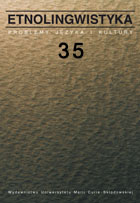Eurolinguistic notes on Polish, German, Czech, Hungarian, Dutch, English, French, Italian, Spanish and Latin in Warmer’s late-17th-c. colloquy. Part 1: Representativeness and address pronouns
Eurolinguistic notes on Polish, German, Czech, Hungarian, Dutch, English, French, Italian, Spanish and Latin in Warmer’s late-17th-c. colloquy. Part 1: Representativeness and address pronouns
Author(s): Joachim GrzegaSubject(s): Theoretical Linguistics, Morphology, Syntax, Pragmatics, Historical Linguistics, Comparative Linguistics, 17th Century
Published by: Wydawnictwo Naukowe Uniwersytetu Marii Curie-Sklodowskiej
Keywords: Christopherus Warmer; cross-linguistic; spoken language; 17th century; address pronouns; representativeness;
Summary/Abstract: Warmer’s 1691 colloquy including ten languages – (Silesian) Polish, (Silesian) German, (eastern) Czech, (northern) Hungarian, (Flemish) Dutch, (northern) French, Italian, Spanish, English and Latin – is studied qualitatively and descriptively for representativeness and typical European character of address forms and routine formulae in expressive speech acts. Due to Warmer’s biography, the content of the book, the comparison to other versions, typographical habits, the uses of address pronouns and their comparison with prior research, the text is considered probably representative of the period from 1650 to 1680. The analysis of address pronouns reveals the following. In all vernacular languages save Dutch, there is a formal/informal address pronoun distinction. Among these languages (except Hungarian), we see the reciprocal use of the formal pronoun between all adults, between students, and between mother and daughter, and non-reciprocal use of the formal pronoun by male non-adults to adults. Based on this, the other pragmalinguistic aspects will be dealt with in the next installment, Part 2 of this study.
Journal: Etnolingwistyka. Problemy Języka I Kultury
- Issue Year: 35/2023
- Issue No: 35
- Page Range: 111-129
- Page Count: 19
- Language: English

